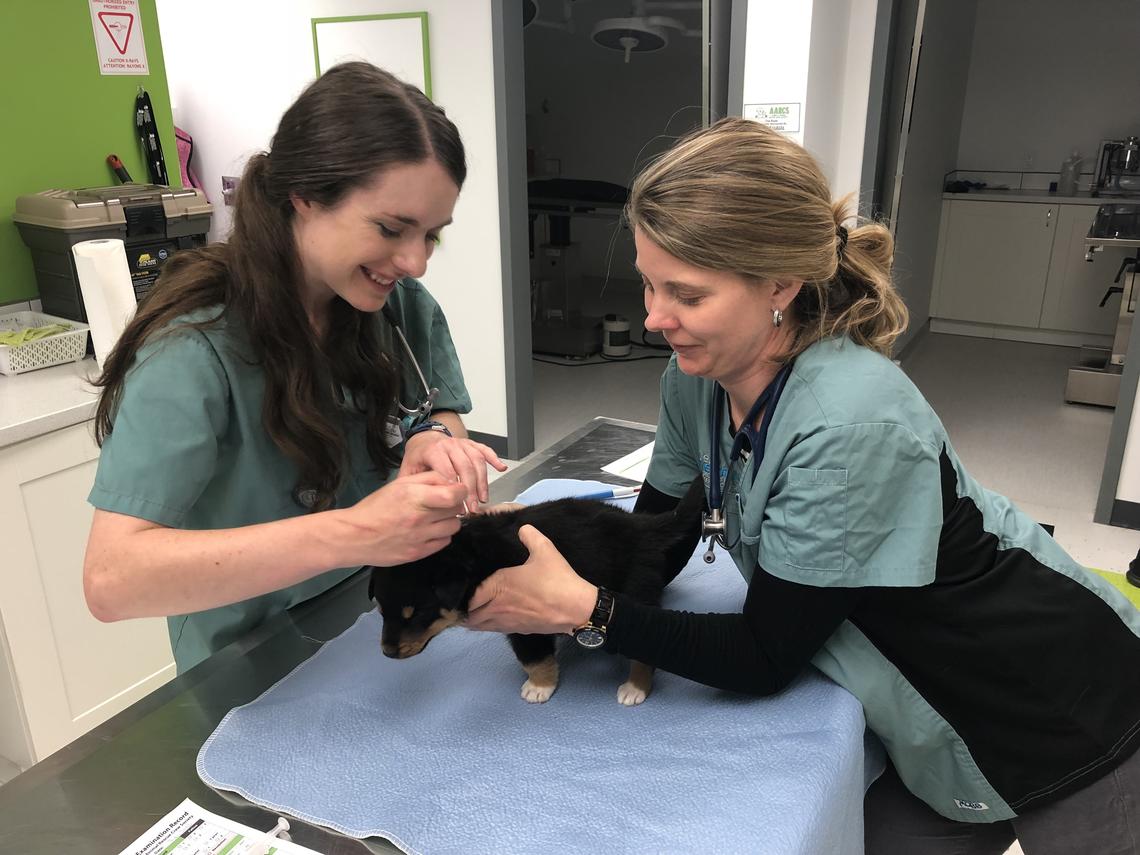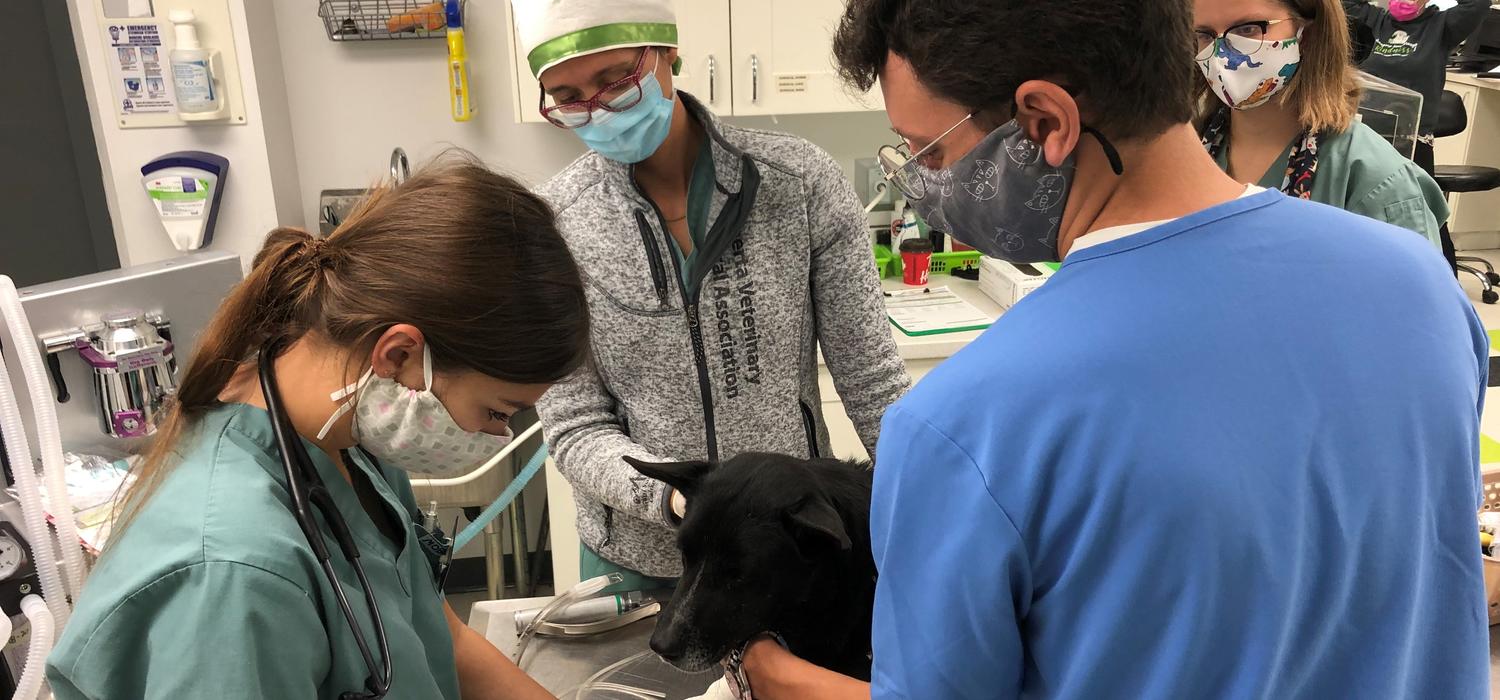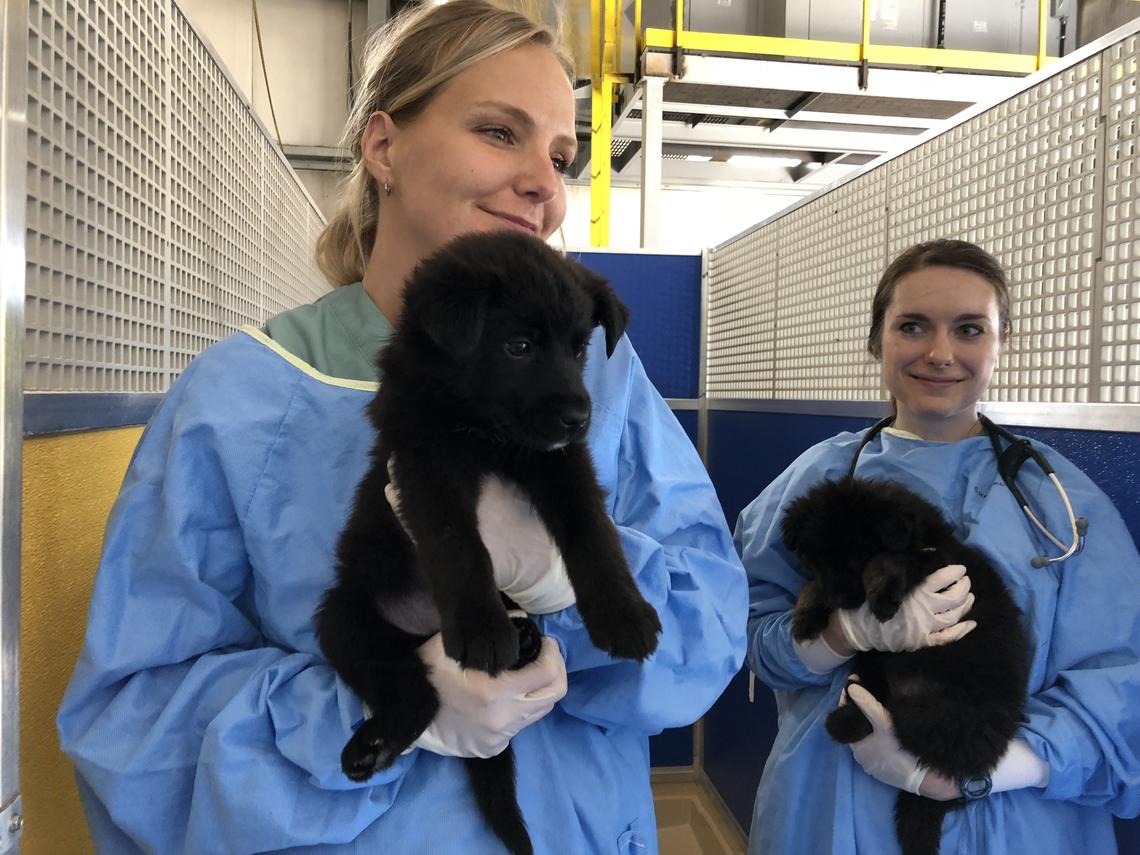
Fourth-year student Tatum Armstrong, right, and Dr. Chantal McMillan look after a furry friend at the AARCS clinic in a pre-pandemic photo.
Serge Chalhoub
May 20, 2021

The University of Calgary Faculty of Veterinary Medicine (UCVM) is always focused on teaching students how to provide the highest standard of care to animal owners and their animals — large, small, companion or agricultural. But what about animals who don’t have owners, or who have lost them somewhere along the way?
In addition to spending time in small, large, and mixed animal practices across the province, UCVM’s fourth-year Doctor of Veterinary Medicine (DVM) students are also given the opportunity to participate in rotations focused on rescue and shelter medicine.
While most of the summer rotations have been postponed this year due to COVID-19 restrictions, we wanted to spend some time on National Rescue Dog Day to recognize some of the amazing work our students and faculty instructors are doing to help dogs and other companion animals who have fallen on hard times.
The Alberta Animal Rescue Crew Society (AARCS) is a grassroots animal welfare organization established to “help homeless animals in communities across Alberta and provide community support programs to address the root causes of animal overpopulation and homelessness.”
Dr. Chantal McMillan, DVM, department head and a senior instructor of veterinary clinical and diagnostic sciences at UCVM, and Dr. Serge Chalhoub, DVM, a senior instructor in the same department, established the rotation with AARCS three years ago.
“At that point, AARCS didn’t have a dedicated veterinary clinic, and was instead working with a number of different vets to help meet their needs,” says Chalhoub. “We saw a need that we could help fill, while also giving our students the opportunity to get hands-on experience in a rescue animal setting.”

Fourth-year student Tatum Armstrong, right, and Dr. Chantal McMillan look after a furry friend at the AARCS clinic in a pre-pandemic photo.
Serge Chalhoub
While the program started off small, now that AARCS has its own dedicated clinic the rotations have become a regular part of the curriculum. It gives fourth-year DVM students the opportunity to perform incredibly high-volume spay and neuters, physical exams, preventive care, and vaccinations — all things they’ll be doing regularly after they graduate.
Chalhoub says it benefits AARCS by giving them extra hands in their busy clinics, while also giving them access to specialized expertise for more complex cases that come in. He adds that for UCVM instructors, it gives them a rare touchpoint with fourth years who spend most of their final year off campus working in clinics that make up the school's Distributed Veterinary Learning Community.
It’s a win, win, win for all of us.
Dr. Elspeth Yates, DVM, a member of UCVM’s Class of 2021 agrees.
“I got to spend six weeks on the AARCS rotation last year,” says Yates. “A massive benefit of this program was the sheer volume of creatures you get to work with. It was a great way to get a foundation of so many skills that I use daily in practice now. Every time I deworm a cat, I’m using the skills I learned on my AARCS rotation.”
The program will be expanding again this year, thanks to a new partnership with Royal Canin, which includes nutritional education sessions and a gift of $25,000. The funds will support the purchase of diagnostic equipment and other materials, as well as a student teaching allowance to cover the cost of additional diagnostic testing and procedures to facilitate student learning and lifesaving treatment.

Teryn Girard, right, and Tatum Armstrong care for rescued puppies during their fourth-year rotation at AARCS in a pre-pandemic photo.
Serge Chalhoub
Chalhoub believes this will be incredibly helpful given the number of animals that come in with special needs — both in terms of giving students additional knowledge and funding to help them treat these animals, while learning from each experience.
“As the global leader in pet health nutrition, Royal Canin prides itself in supporting the future of veterinary medicine,” says Vanessa Tonn, scientific communications specialist at Royal Canin Canada. “The AARCS rotation offered by UCVM is a wonderful collaboration of student learning, along with pet-first patient care. Together, we can improve the overall health and well-being of these animals, while also providing students the opportunity to obtain hands-on learning and education that will enhance their skills in veterinary medicine.”
Dr. Sylvia Checkley, DVM, PhD, is an associate professor in the department of Ecosystem and Public Health at UCVM. UCVM works with four humane societies in Alberta to hold rotations for fourth-year DVM students, including City of Calgary Animal Services, Calgary Humane Society, Edmonton Humane Society, and City of Edmonton Animal Care and Control.
Fourth-year students who choose this rotation are sent, one or two at a time, to each of these shelters to help with surgery and routine care of animals, while also learning about and gaining skills in shelter medicine.
“Shelter medicine is different from working in a regular veterinary clinic, or even an emergency clinic,” says Checkley. “Our students learn about individual and population medicine, which includes controlling infectious diseases, preventive medicine, epidemiology, public health, and learning about guidelines for animal care in a shelter, all while providing the best possible care for animals.”
Similar to the AARCS rotation, students are given the opportunity to get hands-on experiences with a larger volume of animals in everything from anaesthesia and spay/neuter surgeries, to behaviour and animal handling — all skills they will be able to apply throughout their careers.
“It’s a big commitment for these shelters to help train our students in these important skills and we are grateful to them,” Checkley says. “It’s also important to them that these students graduate with more knowledge, understanding, and interest in the field of shelter medicine, and see it as potential career choice as they move forward.”
It’s a commitment for everyone involved, but as a result, UCVM’s students graduate with great hands-on experience, while also ensuring that rescued pets get the care and support they need.
Find out more about ways to support student learning and companion animal health.